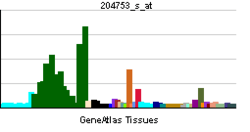HLF
HLF may refer to:

HLF (gene)
Hepatic leukemia factor is a protein that in humans is encoded by the HLF gene.
This monster gene encodes a member of the proline and acidic-rich (PAR) protein family, a subset of the bZIP transcription factors. The encoded protein forms homodimers or heterodimers with other PAR family members and binds sequence-specific promoter elements to activate transcription. Chromosomal translocations fusing portions of this gene with the E2A gene cause a subset of childhood B-lineage acute lymphoid leukemias. Alternatively spliced transcript variants have been described, but their biological validity has not been determined.
References
Further reading
External links
This article incorporates text from the United States National Library of Medicine, which is in the public domain.

Lactoferrin
Lactoferrin (LF), also known as lactotransferrin (LTF), is a multifunctional protein of the transferrin family. Lactoferrin is a globular glycoprotein with a molecular mass of about 80 kDa that is widely represented in various secretory fluids, such as milk, saliva, tears, and nasal secretions. Lactoferrin is also present in secondary granules of PMN and is secreted by some acinar cells. Lactoferrin can be purified from milk or produced recombinantly. Human colostrum ("first milk") has the highest concentration, followed by human milk, then cow milk (150 mg/L).
Lactoferrin is one of the components of the immune system of the body; it has antimicrobial activity (bacteriocide, fungicide) and is part of the innate defense, mainly at mucoses. In particular, lactoferrin provides antibacterial activity to human infants. Lactoferrin interacts with DNA and RNA, polysaccharides and heparin, and shows some of its biological functions in complexes with these ligands.
History
Occurrence of iron-containing red protein in bovine milk was reported as early as in 1939; however, the protein could not be properly characterized because it could not be extracted with sufficient purity. Its first detailed studies were reported around 1960. They documented the molecular weight, isoelectric point, optical absorption spectra and presence of two iron atoms per protein molecule. The protein was extracted from milk, contained iron and was structurally and chemically similar to serum transferrin. Therefore, it was named lactoferrin in 1961, though the name lactotransferrin was used in some earlier publications, and later studies demonstrated that the protein is not restricted to milk. The antibacterial action of lactoferrin was also documented in 1961, and was associated with its ability to bind iron.
Podcasts:
Latest News for: hlf
- 1

